Abstract
The article discusses the relationship between the common standard form of Chinese language – Putonghua and its dialects through the prism of theoretical constructs such as language loyalty and language representation. It is proposed to distinguish two types of instrumental loyalty and evaluative loyalty. Communicative loyalty is associated with the communicative function of the language and assumes the real presence of communicative skills of speakers, but it manifests itself differently and depends on parameters of the communicative situation such as age, social status, level of communicators’ education, but the type of communicative situation is decisive, namely communication among "their own" or among "others". While communicating "among their own", all generations show a high level of communicative loyalty. Evaluative loyalty is connected to the representation of the idiom, in particular to such parameter like its prestige. Indicators evaluative loyalty remain high among the older and middle generations of native speakers of Putonghua and dialect, but the young people consider Putonghua as a more prestigious form. However, the use of dialect is not regarded as vulgar language behavior. At the same time, dialect still is an essential marker of regional cultural identity, and this is how it retains its position. The language law of the PRC regulates the use of dialects.
Keywords: Putonghuathe Chinese dialectinstrumental loyaltyemotive loyaltyrepresentation of languagedomains of Sociolinguistics
Introduction
In the territory of the People's Republic of China, there are more than fifty languages, which belong to different linguistic groups and families. However, the vast majority of the country's citizens (almost 92%) are native speakers of Chinese (Han) language. The standard form of Han language is called Putonghua, i.e., common language, the word "Putong" (普通) in Chinese means «common» and «widespread». The status of Putonghua has been legally consolidated in the «Law of the People's Republic of China on the Standard Spoken and Written Chinese Language», which was adopted in 2001: «For purposes of this Law, the standard spoken and written Chinese language means Putonghua and the standardized Chinese characters (本法所称的国家通用语言文字是普通话和规范汉字 (translated by one of the authors Xue Li)) » (Law 2001). By article 3: «The State popularizes Putonghua and the standardized Chinese characters (国家推广普通话,推行规范汉字) » (Ibid).
A feature of the language situation in China is the existence of many living territorial dialects in the communicative space of the Chinese (Han) language, the degree of understanding among dialects, among dialects and Putonghua, is entirely different, even up to a complete misunderstanding. Based on the structural criteria for distinguishing between the language and dialect of the language, as well as on the criteria of mutual understanding, then it would be possible to consider part of the dialects, in particular, the dialects of the south of the country, as separate languages. This approach exists in some studies of European and, to a lesser extent, Chinese scientists. However, in China, these idioms are officially considered as dialects of the Han language. From the sociolinguistic point of view, they should probably also be regarded as dialects, which is indirectly confirmed by the data from a survey conducted among 60 students, who are the Chinese citizens aged 19 to 24 and study at the People's Friendship University of Russia: on the question of categorization of idiom-dialect all students, without exception, defined them as the dialect of the Chinese language.
The language ideology and policy of the PRC over the 20th century was aimed at the unification of the communicative space of the country, and its absolute priority was the introduction of the common language, which first was named Guoyu (国语), then renamed Putonghua (普通话).
Interest in dialects and recognition of their value as a cultural heritage of the country appeared at the turn of the XX and XXI centuries. There are no special laws on Chinese dialects in the legislation of the PRC. Their use is regulated by article 16 of the «Law of the People's Republic of China on the Standard Spoken and Written Chinese Language». According to this article, the use of dialect in the public sphere is possible in the following cases:
When State functionaries really need to use them in the performance of official duties (国家机关的工作人员执行公务时确需使用的) ;
Where they are used in broadcasting with the approval of the broadcasting and television administration under the State Council or the broadcasting and television department at the provincial level (经国务院广播电视部门或省级广播电视部门批准的播音用语) ;
Where they are needed in traditional operas, films, and TV programs and other forms of art (戏曲、影视等艺术形式中需要使用的) ; and
Where their use is really required in publishing, teaching, and research (出版、教学、研究中确需使用的) (Law 2001)
The public sphere of the use of dialects and their functional load, thus, is limited. At the same time, our research shows that the situation of dialects in China remains stable. They have been being actively used in oral speech in various communicative situations.
Since the primary part of the research was carried out on the material of the Sichuan dialect of the Han language, it is necessary to make a brief introduction to this dialect. Sichuan dialect (四川话) belongs to the Southwestern Mandarin. It is the most widespread Chinese dialect in Sichuan province, Chongqing city, and adjacent areas. The number of speakers of Sichuan dialect exceeds ninety million people.
Chengdu city is the administrative center of Sichuan province, and accordingly, the Chengdu dialect is the exemplary form in terms of pronunciation, for example, for the famous Sichuan Opera and other theatrical productions. However, the dialect itself has no standard and consists of many dialects and subdialects. Since the fact that "there is a high degree of proximity among Sichuan dialects, people who speak different variants can communicate with each other without difficulty, but the Sichuan dialect itself does not have a standard pronunciation" (Zhang, 2005, p. 17).
Problem Statement
The speakers of any dialect are a minority within the ethnic group Han and are speakers of not only specific linguistic, but also cultural variants. It is proposed to study the position of the dialects of the Han language through the prism of such theoretical constructs as loyalty and attitude to the idiom, as well as the social image of the idiom in the minds of its speakers. These important indicators for idioms in the minority situation have consistently high positive value for Chinese speakers. It is suggested to distinguish three types of language loyalty: instrumental loyalty 1 within the domain among "ones’ own" (hereinafter called IL1), instrumental loyalty 2 within the domain among "others" (the official situation of communication, communication beyond the habitual daily circle, etc.) (hereinafter called IL 2) and the evaluative loyalty (hereinafter called EL) (Ciscar, González, & Pérez, 2002). The domain refers to features of the communicative situation such as characteristics and types of communicators, theme, and place of communication (Greenfield, 1970). Instrumental loyalty involves the use of dialect in a communicative function. IL1 is associated with domains such as family, small-populated locality or "one’s own" quarter (communication in a shop, a market, a chemist’s, a local administration, etc.). IL 2 is connected to formal communication situations, prestigious areas of communication, and communication outside the habitual areas of residence. EL as an evaluative type is directly related to the parameters of the social image of the idiom. All these three categories are mental ones, but if the loyalty and social image of the language are static categories and represent the representation of language in the minds of the speakers, then the attitude to the language carries a volitional, dynamic nature.
Research Questions
In the course of the research, the following tasks have been solved:
To describe the real function of dialect and Putonghua in actual communication acts and to study the relation of language/dialect depending on the domain;
To identify the correlation between the age of communicators and the use of a particular variant of the idiom;
To determine the correlation between the domain of language use and its variant;
To verify the hypothesis that currently the leading factor is not the age of the communicators, but the domain;
To analyze the parameters of language loyalty to the dialect of the Han language;
To verify the hypothesis that the dialect has been being one of the primary markers of group cultural identity;
To predict the vitality of the Sichuan dialect of the Han language.
Purpose of the Study
The purpose of this work is to analyze the parameters of language loyalty, related concepts of language representation and attitude to their idiom on the side of the speakers of the dialect. The analysis of these categories is necessary for understanding the real language situation among the speakers of the minority variant of the idiom, and for predicting its vitality. The central part of the research was conducted on the material of Sichuan dialect of the Chinese language.
Research Methods
The empirical part of the research consisted of two parts: firstly, it was necessary to investigate the actual use of the dialect and, secondly, to identify the degree of loyalty to the dialect which is used (in this case, to Sichuan dialect). For this purpose, the domain "local market" and the domain "prestigious store" were selected in the capital of Sichuan province - Chengdu. The most optimum methods of the research were considered to include the observation of the speakers’ language behavior. The following research plan was offered: one of the authors of the article carried out an observation of the communicative behavior of sellers and buyers in the markets and expensive shops in Chengdu (Sichuan province). Fifteen low-cost markets intended for residents of the various quarter and selling food, as well as the same number of luxury shops in Chengdu, which are usually located in the downtown or the prestigious areas of the city, were visited. Observation of the communication language (Putonghua or dialect) of buyers and sellers was conducted. The data were recorded in the table where the date, place of observation, the approximate age of communicators and language of communication were indicated. Data on 251 acts of micro-communication (143 in markets and 108 in stores) was collected.
In order to determine the level of loyalty to the dialect and Putonghua, the data from two questionnaire surveys were used. A survey of 60 students aged 19 to 24 years, who are studying in the Peoples' Friendship University of Russia, was carried out. The questions of the questionnaire were aimed at identifying the level of loyalty to the use of the Chinese dialects. The dialect could be any one, depending on the region of residence of the student. Then, the data from an online survey of attitudes towards the Sichuan dialect was quoted (Reviewed: https://www.wjx.cn/report/8194490.aspx (30/03/2019)) .
Findings
The results obtained in the course of the research will be presented. At first, this section will focus on the use of language and dialect in different communicative situations. Then it will bring in the data on the parameter of language loyalty.
The language usage in various communicative situations
Figure
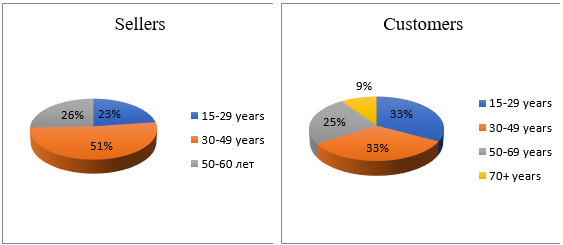
All participants of the communication activities in the markets of Chengdu were local residents, or at least, had a command of a local version of the dialect. They were representatives of all age groups, which is explained by the habit and convenience of buying products in the market nearest to home. Of the 143 people (70 sellers and 73 customers) only one customer spoke Putonghua (he was not a local resident). All the others spoke dialect. Thus, the use of dialect within the domain "among ones’ own" is almost 100%. IL1 is high.
Figure
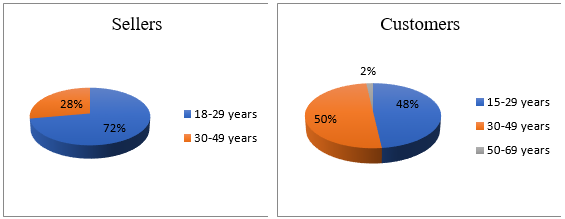
The age of sellers in the stores of the expensive segment is much younger than sellers in the markets. The age of customers is also younger. The ratio of the use of Putonghua and dialect is precisely the opposite. Out of 108 people (54 sellers and 54 customers), only 8 people (all customers) speak dialect. The sellers in 100% of the cases responded in Putonghua, even if the customer spoke dialect. That is, the ratio of Putonghua accounts for 92.6% of communication, while the ratio of the dialect for 7.4%.
Figure
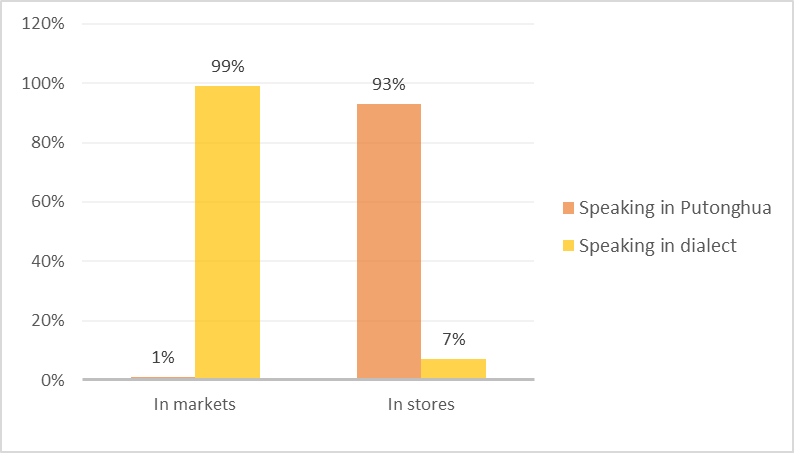
It should be mentioned that article 13 of the «Law of the PRC on the Standard Spoken and Written Chinese Language» states that "people working in the service trade are encouraged to use Putonghua when providing services" (提倡公共服务行业以普通话为服务用语
) (Law 2001). Also, it needs to take into account the fact that visitors who go to expensive shops (or shopping centers) could be not only residents but also visitors from other regions who do not speak the Sichuan dialect. In this situation, Putonghua is used as a common language of communication.
In General, observations confirm that in daily life among «their own» residents prefer to speak dialect. In public places, including expensive shops, the dialect is rarely used. The results of language policy on the introduction and promotion of Putonghua has brought benefit. The younger generation, who has accepted the full course of education in Putonghua, speaks it more often than the dialect. The correlation between «age group» and the use of Putonghua/dialect needs to be verified through the constructs of instrumental and evaluative loyalty on different groups of idiom speakers.
Loyalty and attitude to the standard form of language and the dialect
It is now moving on to the second parameter that is studied in this article, namely, language loyalty to the dialect. In the following, it is presented the data from a survey of students from RUDN about their attitude to Putonghua and dialects. A total of 60 students took part in this survey, of which 32 were male, and 28 were female students. Out of 100%, 93% of people indicated that they know one of the Chinese dialects, one person pointed out that he understands the dialect, but cannot speak it. To the question "do I need to know the dialect? ", 83% of students responded positively, and 17% of the interviewees considered that knowing the dialect is "optional". To the question "Which gains the high prestige: dialect or Putonghua?", 90% of the interviewees chose "Putonghua", 10% answered "Both". No one marked dialect as a more prestigious form. To the question "Which version of the language do You use most often: Putonghua or dialect?", students who answered "Putonghua" accounted for 90% of the interviewees, 10% indicated that they speak the dialect more often.
The questions of this questionnaire were, undoubtedly, very general. However, the answers to them provide an idea of the loyalty types and the vectors of attitude to the dialect. These responses confirm that the level of instrumental loyalty to the dialect remains high, but the prior use of Putonghua is prevalent among the Chinese younger generation.
The high level of instrumental loyalty is confirmed by the results of an online survey conducted by the association SOJUMP (Reviewed: https://www.wjx.cn/jq/四川方言使用现状调查 (30/03/2019)) . Question 3, 4, 5 and 8 of this questionnaire relate to instrumental loyalty. Question 7 and 9 are more relevant to the representation of the dialect in the mind of its speakers. In Figure
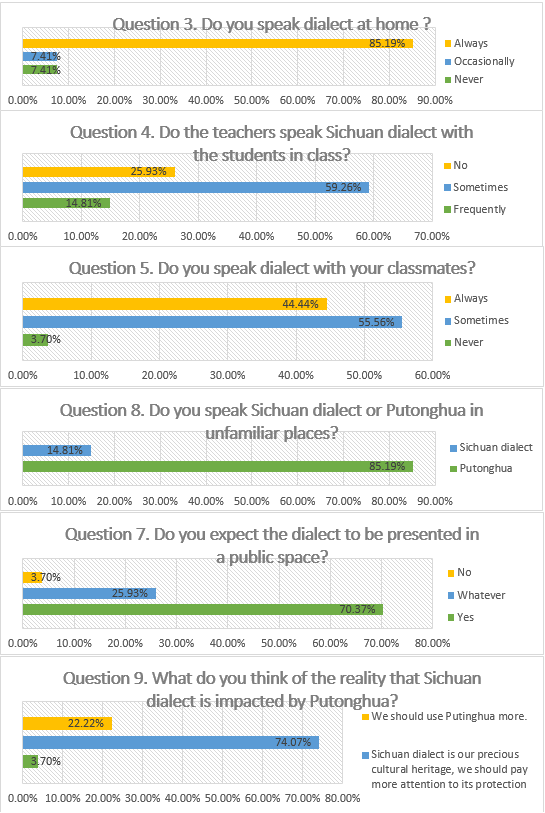
These data indicate a high degree of proficiency in the dialect form of the Chinese language, as well as its widespread use within the domain “communication with their own”. The evaluative type of loyalty is also affirmative.
Issues of evaluative loyalty were investigated in the work of Chinese scientists Zuo and Lv (2016).
In their research, of all interviewees, 80% agree to communicate in dialect and 70% in Putonghua. 5% of the interviewees turned out to be unaccustomed to communicate in dialect, and 13% were unaccustomed to communicate in Putonghua.
To the question "Speaking dialect – is it vulgar?", 92, 6% of the interviewees gave a negative answer. Moreover, only 7.4% agreed with this statement. It is interesting to note that communication in dialect was perceived as a vulgar behavior mainly by poorly educated sections of the population.
In Zuo and Lv’s (2016) research answers by different age cohorts to the question "Whether Putonghua enriches dialects?" is unusual. The answers to this question are shown in Figure
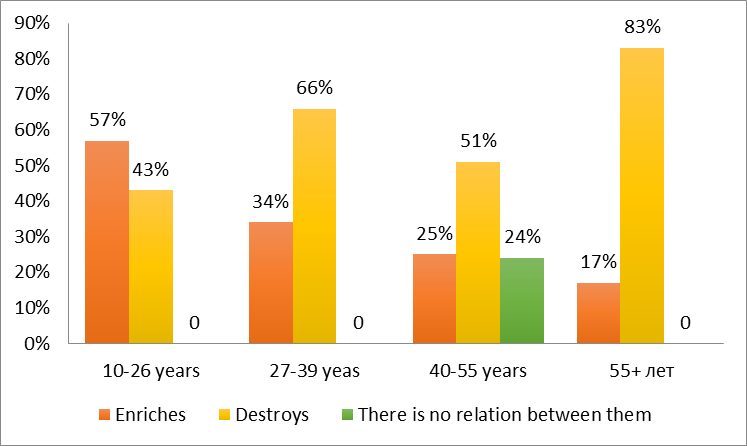
The figure shows that the perception of the positive influence of Putonghua on the dialect decreases depending on the age of the interviewees and, their knowledge of the dialect, since the older generation, without doubt, masters the dialect better. The dynamic growth of the opinion that Putonghua destroys the dialect forms of the language causes concerns for their safety in the future.
Conclusion
From the conducted researches, it is possible to point out the high frequency of dialect use in communicative situations within informal environments, within the domain "ones’ own". Instrumental loyalty associated with the use of dialect in the communicative function also remains high. The correlation between the use of dialect and the age of the communicator exists (the younger generation prefers to speak Putonghua), but it is expressed more at the level of representation than at the level of real communication. The method of conducted observation revealed that the use of language by both young and older native speakers remains high frequently while communicating with "their own". The method of the questionnaire survey of young people indicates that the younger generation more emphasizes on the use of Putonghua. The domain plays a decisive role in the choice of means of communication. If communication occurs in less formal and neutral conditions, the preference is given to Putonghua. High rates of evaluative loyalty are characteristic of elder age cohorts. Young people with high instrumental loyalty demonstrates a low level of evaluative loyalty. Meanwhile, the dialect has been being a significant marker of cultural and group identity. In this role, his position is still relevant, and vitality stays high.
Acknowledgments
The publication has been prepared with the support of the “RUDN University Program 5–100”.
References
- Ciscar, R.L., González, M.D., & Pérez, L.P. (2002). Llealtats i actituds lingüístiques al país Valencia. Noves SL. Revista de Sociolingüística, 1-9. Retrieved from http://www.gencat.cat/llengua/noves/noves/hm02primavera/catalana/ciscar.pdf [In Catalan].
- Greenfield, L. (1970). Situational measures of normative language views in relation to person, place and topic among Puerto Rican bilinguals. Antropos, 65, 602-618.
- Law (2001). Low of the People's Republic of China on the Standard Spoken and Written Chinese Language [中华人民共和国国家通用语言文字法]. – Peking: Language & Culture Publishing House [语言&文化出版社].
- Zhang, S. (2005). Basic introduction of Sichuan dialect [张绍诚 巴蜀方言浅说]. Bashu Publishing House [巴蜀书社].
- Zuo, X., & Lv, W. (2016). An investigation on dialect usage and attitude. Journal of Beijing International Studies University, 38(1), 25-45.
Copyright information

This work is licensed under a Creative Commons Attribution-NonCommercial-NoDerivatives 4.0 International License.
About this article
Publication Date
14 July 2019
Article Doi
eBook ISBN
978-1-80296-063-1
Publisher
Future Academy
Volume
64
Print ISBN (optional)
-
Edition Number
1st Edition
Pages
1-829
Subjects
Psychology, educational psychology, counseling psychology
Cite this article as:
Aleksandrova, O., Moskvitcheva*, S., & Li, X. (2019). Language Loyalty And Representation Of Dialects In The People’s Republic Of China. In T. Martsinkovskaya, & V. R. Orestova (Eds.), Psychology of Subculture: Phenomenology and Contemporary Tendencies of Development, vol 64. European Proceedings of Social and Behavioural Sciences (pp. 299-308). Future Academy. https://doi.org/10.15405/epsbs.2019.07.39
